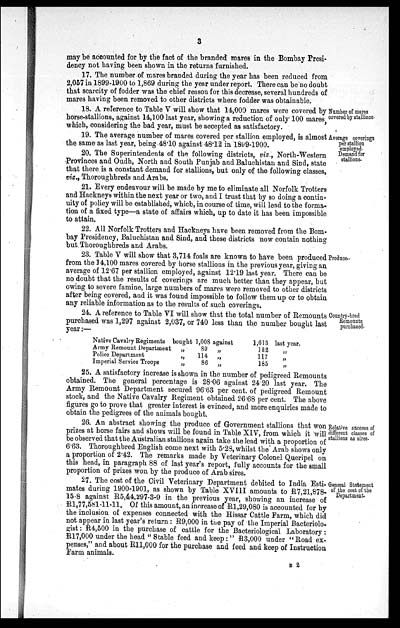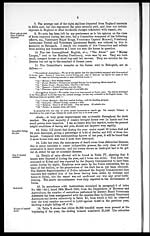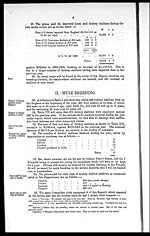Medicine - Veterinary > Civil Veterinary Departments > Annual administration report of the Civil Veterinary Department of India > 1900-1901 > Part I - Imperial report
(15) Page 3
Download files
Individual page:
Thumbnail gallery: Grid view | List view

3
may be accounted for by the fact of the branded mares in the Bombay Presi-
dency not having been shown in the returns furnished.
17. The number of mares branded during the year has been reduced from
2,057 in 1899-1900 to 1,869 during the year under report. There can be no doubt
that scarcity of fodder was the chief reason for this decrease, several hundreds of
mares having been removed to other districts where fodder was obtainable.
Number of mares
covered by stallions.
18. A reference to Table V will show that 14,000 mares were covered by
horse-stallions, against 14,100 last year, showing a reduction of only 100 mares,
which, considering the bad year, must be accepted as satisfactory.
Average coverings
per stallion
employed.
Demand for
stallions.
19. The average number of mares covered per stallion employed, is almost.
the same as last year, being 48.10 against 48.12 in 1899-1900.
20. The Superintendents of the following districts, viz., North-Western
Provinces and Oudh, North and South Punjab and Baluchistan and Sind, state
that there is a constant demand for stallions, but only of the following classes,
viz., Thoroughbreds and Arabs.
21. Every endeavour will be made by me to eliminate all Norfolk Trotters
and Hackneys within the next year or two, and I trust that by so doing a contin-
uity of policy will be established, which, in course of time, will lead to the forma-
tion of a fixed type—a state of affairs which, up to date it has been impossible
to attain.
22. All Norfolk Trotters and Hackneys have been removed from the Bom-
bay Presidency, Baluchistan and Sind, and these districts now contain nothing
but Thoroughbreds and Arabs.
Produce.
23. Table V will show that 3,714 foals are known to have been produced
from the14,100 mares covered by horse stallions in the previous year, giving an
average of 12.67 per stallion employed, against 12.19 last year. There can be
no doubt that the results of coverings are much better than they appear, but
owing to severe famine, large numbers of mares were removed to other districts
after being covered, and it was found impossible to follow them up or to obtain
any reliable information as to the results of such coverings.
Country-bred
Remounts
purchased.
24. A reference to Table VI will show that the total number of Remounts
purchased was 1,297 against 2,037, or 740 less than the number bought last
year:—
|
Native Cavalry Regiments bought 1,008 against |
1,613 |
last year. |
|
Army Remount Department „ 89 „ |
122 |
„ |
|
Police Department „ 114 „ |
117 |
„ |
|
Imperial Service Troops „ 86 „ |
185 |
„ |
25. A satisfactory increase is shown in the number of pedigreed Remounts
obtained. The general percentage is 28.06 against 24 20 last year. The
Army Remount Department secured 96.63 per cent. of pedigreed Remount
stock, and the Native Cavalry Regiment obtained 26.68 per cent. The above
figures go to prove that greater interest is evinced, and more enquiries made to
obtain the pedigrees of the animals bought.
Relative success of
different classes of
stallions as sires.
26. An abstract showing the produce of Government stallions that won
prizes at horse fairs and shows will be found in Table XIV, from which it will
be observed that the Australian stallions again take the lead with a proportion of
6.63. Thoroughbred English come next with 5.28, whilst the Arab shows only
a proportion of 2.42. The remarks made by Veterinary Colonel Queripel on
this head, in paragraph 88 of last year's report, fully accounts for the small
proportion of prizes won by the produce of Arab sires.
General Statement
of the cost of the
Department.
27. The cost of the Civil Veterinary Department debited to India Esti-
mates during 1900-1901, as shown by Table XVIII amounts to R7,21,878-
15.8 against R5,44,297-3-9 in the previous year, showing an increase of
R1,77,581-11-11. Of this amount, an increase of R1,29,080 is accounted for by
the inclusion of expenses connected with the Hissar Cattle Farm, which did
not appear in last year's return: R9,000 in the pay of the Imperial Bacteriolo-
gist: R4,500 in the purchase of cattle for the Bacteriological Laboratory:
R17,000 under the head "Stable feed and keep:" R3,000 under "Road ex-
penses," and about R11,000 for the purchase and feed and keep of Instruction
Farm animals.
B 2
Set display mode to: Large image | Zoom image | Transcription
Images and transcriptions on this page, including medium image downloads, may be used under the Creative Commons Attribution 4.0 International Licence unless otherwise stated. ![]()
| India Papers > Medicine - Veterinary > Civil Veterinary Departments > Annual administration report of the Civil Veterinary Department of India > 1900-1901 > Imperial report > (15) Page 3 |
|---|
| Permanent URL | https://digital.nls.uk/75508002 |
|---|




